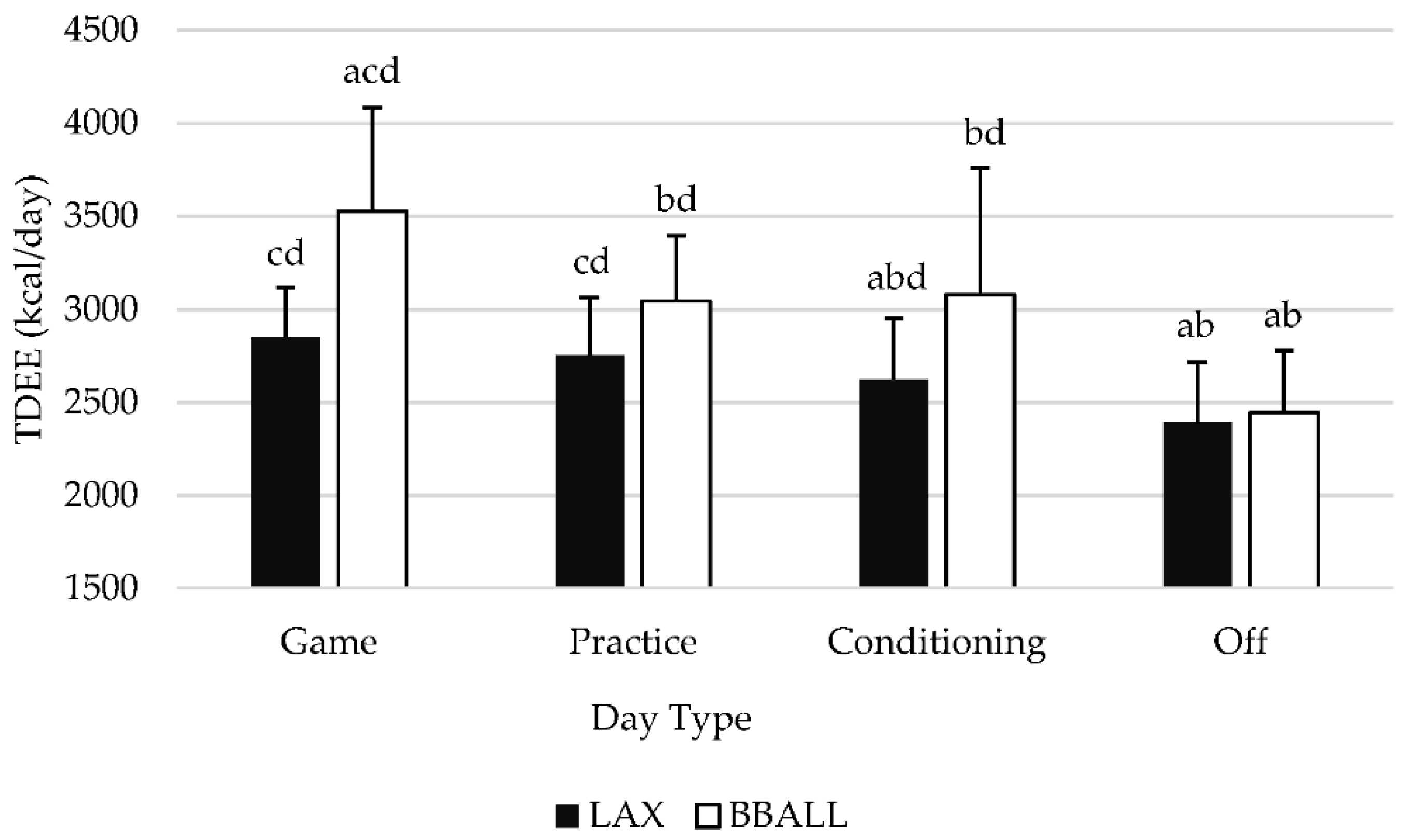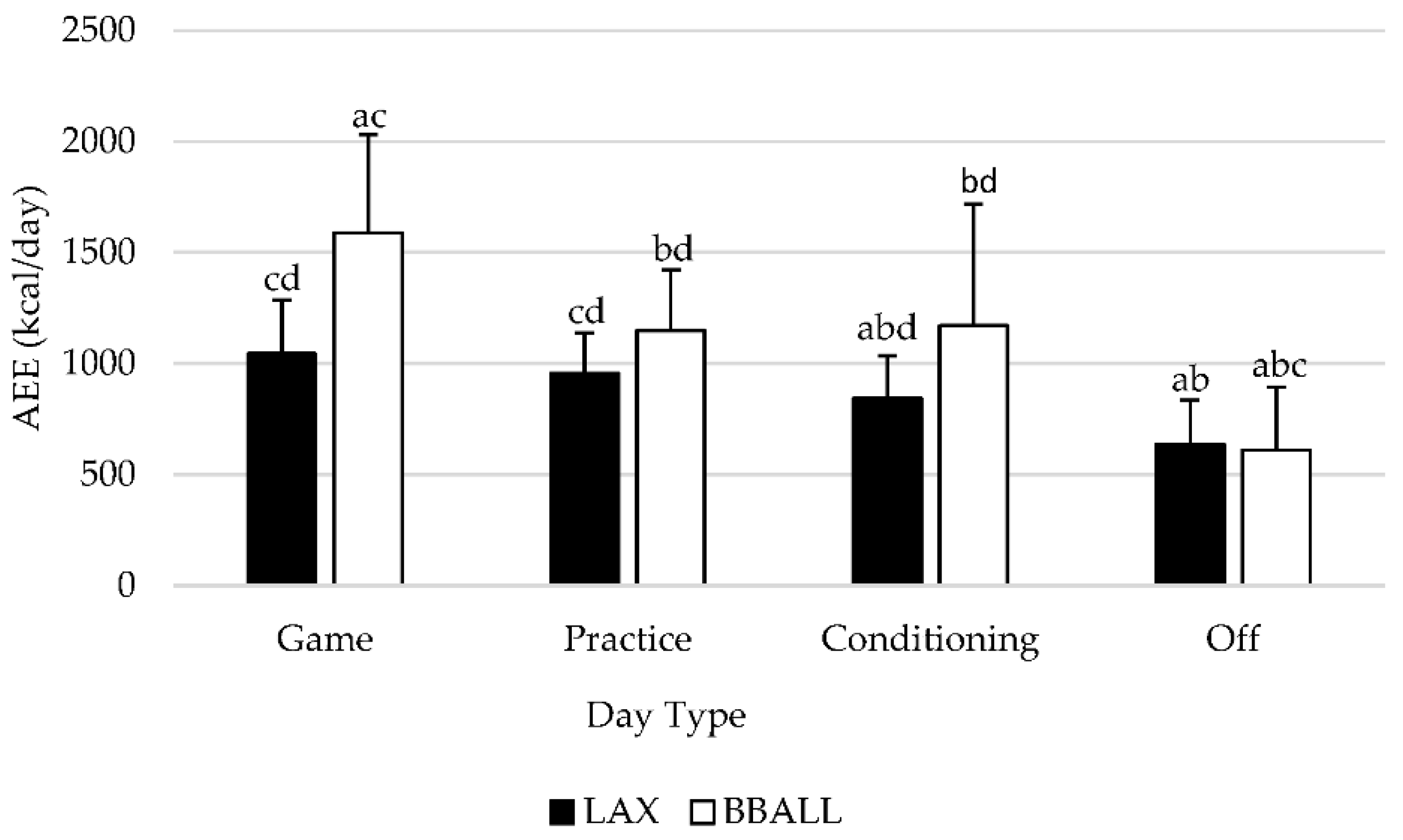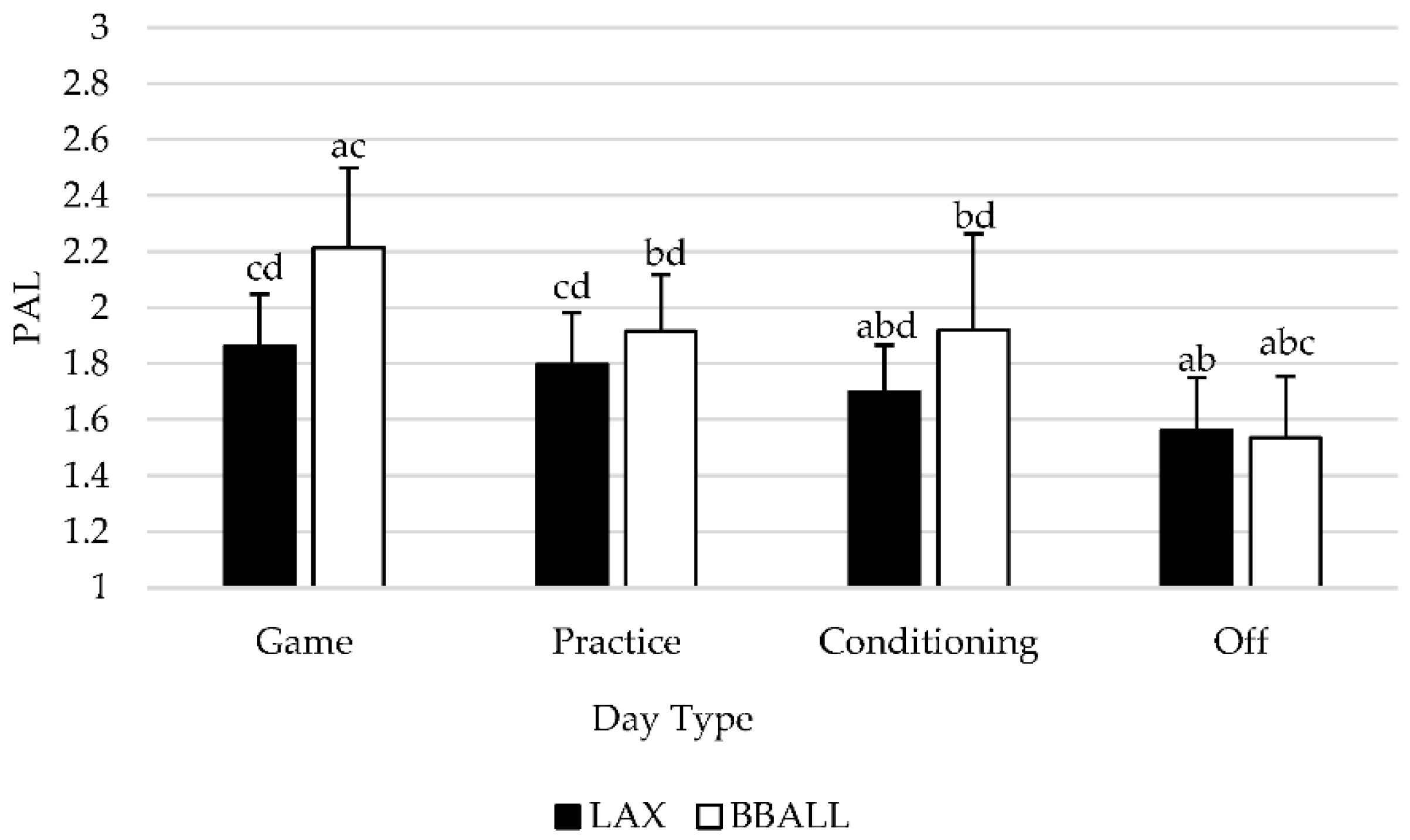Comparison of Energy Expenditure Observed between Scheduled Activities in Collegiate Team-Sport Female Athletes
Abstract
1. Introduction
2. Methods
2.1. Experimental Design
2.2. Subjects
2.3. Procedures
2.3.1. Anthropometrics and Body Composition
2.3.2. Physical Activity Monitoring
2.3.3. Day Classification
2.4. Statistical Analysis
3. Results
3.1. Participant Anthropometrics by Sport
3.2. Total Daily Energy Expenditure
3.3. Activity Energy Expenditure
3.4. Physical Activity Levels
4. Discussion
Author Contributions
Funding
Institutional Review Board Statement
Informed Consent Statement
Data Availability Statement
Acknowledgments
Conflicts of Interest
References
- Drenowatz, C.; Hand, G.A.; Shook, R.P.; Jakicic, J.M.; Hebert, J.R.; Burgess, S.; Blair, S.N. The Association Between Different Types Of Exercise And Energy Expenditure In Young Nonoverweight And Overweight Adults. Appl. Physiol. Nutr. Metab. 2015, 40, 211–217. [Google Scholar] [CrossRef]
- Donahoo, W.T.; Levine, J.A.; Melanson, E.L. Variability In Energy Expenditure And Its Components. Curr. Opin. Clin. Nutr. Metab. Care. 2004, 7, 599–605. [Google Scholar] [CrossRef]
- Wilson, P.B.; Madrigal, L.A.; Burnfield, J.M. Weight Control Practices Of Division I National Collegiate Athletic Association Athletes. Phys. Sportsmed. 2016, 44, 170–176. [Google Scholar] [CrossRef] [PubMed]
- Drenowatz, C.; Eisenmann, J.C.; Carlson, J.J.; Pfeiffer, K.A.; Pivarnik, J.M. Energy Expenditure And Dietary Intake During High-Volume And Low-Volume Training Periods Among Male Endurance Athletes. Appl. Physiol. Nutr. Metab. 2012, 37, 199–205. [Google Scholar] [CrossRef] [PubMed]
- Loucks, A.B. Low Energy Availability In The Marathon And Other Endurance Sports. Sports Med. 2007, 37, 348–352. [Google Scholar] [CrossRef] [PubMed]
- Schaal, K.; Tiollier, E.; Le Meur, Y.; Casazza, G.; Hausswirth, C. Elite Synchronized Swimmers Display Decreased Energy Availability During Intensified Training. Scand. J. Med. Sci. Sports 2017, 27, 925–934. [Google Scholar] [CrossRef]
- Joy, E.A.; Campbell, D. Stress Fractures In The Female Athlete. Curr. Sports Med. Rep. 2005, 4, 323–328. [Google Scholar] [CrossRef]
- Novas, A.; Rowbottom, D.; Jenkins, D. Total Daily Energy Expenditure And Incidence Of Upper Respiratory Tract Infection Symptoms In Young Females. Int. J. Sports Med. 2002, 23, 465–470. [Google Scholar] [CrossRef]
- Schaal, K.; VanLoan, M.D.; Hausswirth, C.; Casazza, G.A. Decreased Energy Availability During Training Overload Is Associated With Non-Functional Overreaching And Suppressed Ovarian Function In Female Runners. Appl. Physiol. Nutr. Metab. 2021. [Google Scholar] [CrossRef]
- Logue, D.M.; Madigan, S.M.; Melin, A.; Delahunt, E.; Heinen, M.; Donnell, S.J.M.; Corish, C.A. Low Energy Availability In Athletes 2020: An Updated Narrative Review Of Prevalence, Risk, Within-Day Energy Balance, Knowledge, And Impact On Sports Performance. Nutrients 2020, 12, 835. [Google Scholar] [CrossRef]
- Mountjoy, M.; Sundgot-Borgen, J.; Burke, L.; Carter, S.; Constantini, N.; Lebrun, C.; Meyer, N.; Sherman, R.; Steffen, K.; Budgett, R.; et al. The Ioc Consensus Statement: Beyond The Female Athlete Triad--Relative Energy Deficiency In Sport (Red-S). Br. J. Sports Med. 2014, 48, 491–497. [Google Scholar] [CrossRef]
- Gama, E.; Kasuki, L.; Paranhos-Neto, F.P.; Madeira, M.; Mendonça, L.M.C.; Schtscherbyna, A.; Farias, M.L.F. Low Energy Availability Interferes With Exercise-Associated Bone Effects In Female Long-Distance Triathletes As Detected By Hr-Pqct. J. Clin. Densitom. 2021. [Google Scholar] [CrossRef] [PubMed]
- Ihalainen, J.K.; Kettunen, O.; McGawley, K.; Solli, G.S.; Hackney, A.C.; Mero, A.A.; Kyröläinen, H. Body Composition, Energy Availability, Training, And Menstrual Status In Female Runners. Int. J. Sports Physiol. Perform. 2021, 1, 1–6. [Google Scholar]
- Bolonchuk, W.W.; Lukaski, H.C.; Siders, W.A. The Structural, Functional, And Nutritional Adaptation Of College Basketball Players Over A Season. J. Sports Med. Phys. Fit. 1991, 31, 165–172. [Google Scholar]
- Gonzalez, A.M.; Hoffman, J.R.; Scallin-Perez, J.R.; Stout, J.R.; Fragala, M.S. Performance Changes In National Collegiate Athletic Association Division I Women Basketball Players During A Competitive Season: Starters Vs. Nonstarters. J. Strength Cond. Res. 2012, 26, 3197–3203. [Google Scholar] [CrossRef]
- Reed, J.L.; De Souza, M.J.; Williams, N.I. Changes In Energy Availability Across The Season In Division I Female Soccer Players. J. Sports Sci. 2013, 31, 314–324. [Google Scholar] [CrossRef]
- Silva, A.M.; Matias, C.N.; Santos, D.A.; Thomas, D.; Bosy-Westphal, A.; Müller, M.J.; Heymsfield, S.B.; Sardinha, L.B. Compensatory Changes In Energy Balance Regulation Over One Athletic Season. Med. Sci. Sports Exerc. 2017, 49, 1229–1235. [Google Scholar] [CrossRef]
- Silva, A.M.; Santos, D.A.; Matias, C.N.; Rocha, P.M.; Petroski, E.L.; Minderico, C.S.; Sardinha, L.B. Changes In Regional Body Composition Explain Increases In Energy Expenditure In Elite Junior Basketball Players Over The Season. Eur. J. Appl. Physiol. 2012, 112, 2727–2737. [Google Scholar] [CrossRef]
- Ebine, N.; Rafamantanantsoa, H.H.; Nayuki, Y.; Yamanaka, K.; Tashima, K.; Ono, T.; Saitoh, S.; Jones, P.J. Measurement Of Total Energy Expenditure By The Doubly Labelled Water Method In Professional Soccer Players. J. Sports Sci. 2002, 20, 391–397. [Google Scholar] [CrossRef] [PubMed]
- Gibson, J.C.; Stuart-Hill, L.; Martin, S.; Gaul, C. Nutrition Status Of Junior Elite Canadian Female Soccer Athletes. Int. J. Sport Nutr. Exerc. Metab. 2011, 21, 507–514. [Google Scholar] [CrossRef] [PubMed]
- Woodruff, S.J.; Meloche, R.D. Energy Availability Of Female Varsity Volleyball Players. Int. J. Sport Nutr. Exerc. Metab. 2013, 23, 24–30. [Google Scholar] [CrossRef] [PubMed]
- Mara, J.K.; Thompson, K.G.; Pumpa, K.L. Assessing The Energy Expenditure Of Elite Female Soccer Players: A Preliminary Study. J. Strength Cond. Res. 2015, 29, 2780–2786. [Google Scholar] [CrossRef] [PubMed]
- Sell, K.M.; Ledesma, A.B. Heart Rate And Energy Expenditure In Division I Field Hockey Players During Competitive Play. J. Strength Cond. Res. 2016, 30, 2122–2128. [Google Scholar] [CrossRef] [PubMed]
- Magee, M.K.; Lockard, B.L.; Zabriskie, H.A.; Schaefer, A.Q.; Luedke, J.A.; Erickson, J.L.; Jones, M.T.; Jagim, A.R. Prevalence Of Low Energy Availability In Collegiate Women Soccer Athletes. J. Funct. Morphol. Kinesiol. 2020, 5, 96. [Google Scholar] [CrossRef] [PubMed]
- Melin, A.; Tornberg, Å.B.; Skouby, S.; Møller, S.S.; Sundgot-Borgen, J.; Faber, J.; Sidelmann, J.J.; Aziz, M.; Sjödin, A. Energy Availability And The Female Athlete Triad In Elite Endurance Athletes. Scand. J. Med. Sci. Sports 2015, 25, 610–622. [Google Scholar] [CrossRef] [PubMed]
- Hill, R.J.; Davies, P.S. Energy Intake And Energy Expenditure In Elite Lightweight Female Rowers. Med. Sci. Sports Exerc. 2002, 34, 1823–1829. [Google Scholar] [CrossRef]
- Barreto, G.; de Oliveira, L.F.; Saito, T.; Klosterhoff, R.; Perim, P.; Dolan, E.; Pereira, R.M.R.; Campos-Ferraz, P.; Lima, F.R.; Saunders, B. Reduced Endurance Capacity And Suboptimal Energy Availability In Top-Level Female Cyclists. Int. J. Sports Physiol. Perform. 2021, 1, 1–10. [Google Scholar]
- Zabriskie, H.A.; Currier, B.S.; Harty, P.S.; Stecker, R.A.; Jagim, A.R.; Kerksick, C.M. Energy Status And Body Composition Across A Collegiate Women’s Lacrosse Season. Nutrients 2019, 11, 470. [Google Scholar] [CrossRef]
- Zanders, B.R.; Currier, B.S.; Harty, P.S.; Zabriskie, H.A.; Smith, C.R.; Stecker, R.A.; Richmond, S.R.; Jagim, A.R.; Kerksick, C.M. Changes In Energy Expenditure, Dietary Intake, And Energy Availability Across An Entire Collegiate Women’s Basketball Season. J. Strength Cond. Res. 2018, 35, 804–810. [Google Scholar] [CrossRef]
- Devlin, B.L.; Kingsley, M.; Leveritt, M.D.; Belski, R. Seasonal Changes In Soccer Players’ Body Composition And Dietary Intake Practices. J. Strength Cond. Res. 2017, 31, 3319–3326. [Google Scholar] [CrossRef]
- Reilly, T.; Waterhouse, J.; Burke, L.M.; Alonso, J.M. Nutrition For Travel. J. Sports Sci. 2007, 25 (Suppl. 1), S125–S134. [Google Scholar] [CrossRef] [PubMed]
- Couture, S.; Lamarche, B.; Morissette, E.; Provencher, V.; Valois, P.; Goulet, C.; Drapeau, V. Evaluation Of Sports Nutrition Knowledge And Recommendations Among High School Coaches. Int. J. Sport Nutr. Exerc. Metab. 2015, 25, 326–334. [Google Scholar] [CrossRef] [PubMed]
- Danaher, K.; Curley, T. Nutrition Knowledge And Practices Of Varsity Coaches At A Canadian University. Can. J. Diet Pr. Res. 2014, 75, 210–213. [Google Scholar] [CrossRef] [PubMed]
- Heikkila, M.; Valve, R.; Lehtovirta, M.; Fogelholm, M. Nutrition Knowledge Among Young Finnish Endurance Athletes And Their Coaches. Int. J. Sport Nutr. Exerc. Metab. 2018, 28, 522–527. [Google Scholar] [CrossRef]
- Abood, D.A.; Black, D.R.; Birnbaum, R.D. Nutrition Education Intervention For College Female Athletes. J. Nutr. Educ. Behav. 2004, 36, 135–139. [Google Scholar] [CrossRef]
- Rossi, F.E.; Landreth, A.; Beam, S.; Jones, T.; Norton, L.; Cholewa, J.M. The Effects Of A Sports Nutrition Education Intervention On Nutritional Status, Sport Nutrition Knowledge, Body Composition, And Performance During Off Season Training In Ncaa Division I Baseball Players. J. Sports Sci. Med. 2017, 16, 60. [Google Scholar]
- Burke, L. Fueling Strategies To Optimize Performance: Training High Or Training Low? Scand. J. Med. Sci. Sports 2010, 20, 48–58. [Google Scholar] [CrossRef]
- Fernandes, H.S. Carbohydrate Consumption And Periodization Strategies Applied To Elite Soccer Players. Curr. Nutr. Rep. 2020, 9, 1–6. [Google Scholar] [CrossRef]
- Crouter, S.E.; Churilla, J.R.; Bassett, D.R., Jr. Accuracy Of The Actiheart For The Assessment Of Energy Expenditure In Adults. Eur. J. Clin. Nutr. 2008, 62, 704–711. [Google Scholar] [CrossRef]
- Briggs, M.A.; Cockburn, E.; Rumbold, P.L.; Rae, G.; Stevenson, E.J.; Russell, M. Assessment Of Energy Intake And Energy Expenditure Of Male Adolescent Academy-Level Soccer Players During A Competitive Week. Nutrients 2015, 7, 8392–8401. [Google Scholar] [CrossRef]
- Heydenreich, J.; Kayser, B.; Schutz, Y.; Melzer, K. Total Energy Expenditure, Energy Intake, And Body Composition In Endurance Athletes Across The Training Season: A Systematic Review. Sports Med. Open 2017, 3, 8. [Google Scholar] [CrossRef]
- Tooley, E.; Bitcon, M.; Briggs, M.A.; West, D.J.; Russell, M. Estimates Of Energy Intake And Expenditure In Professional Rugby League Players. Int. J. Sports Sci. Coach. 2015, 10, 551–560. [Google Scholar] [CrossRef]
- Spear, B.A. Adolescent Growth And Development. J. Acad. Nutr. Diet. 2002, 102, S23–S29. [Google Scholar] [CrossRef]
- Petrie, H.J.; Stover, E.A.; Horswill, C.A. Nutritional Concerns For The Child And Adolescent Competitor. Nutrition 2004, 20, 620–631. [Google Scholar] [CrossRef]
- Nichols, J.F.; Aralis, H.; Merino, S.G.; Barrack, M.T.; Stalker-Fader, L.; Rauh, M.J. Utility Of The Actiheart Accelerometer For Estimating Exercise Energy Expenditure In Female Adolescent Runners. Int. J. Sport Nutr. Exerc. Metab. 2010, 20, 487–495. [Google Scholar] [CrossRef] [PubMed]



| Variable | Basketball (n = 13) | Lacrosse (n = 20) | p-Value |
|---|---|---|---|
| Age (years) | 19.8 ± 1.3 | 20.4 ± 1.8 | 0.061 |
| Height (cm) | 173.9 ± 13.6 | 168.4 ± 6.6 | 0.004 † |
| Weight (kg) | 74.6 ± 9.1 | 68.8 ± 8.9 | 0.097 |
| DEXA Body Fat % | 27.1 ± 3.2 | 27.9 ± 3.1 | 0.847 |
| DEXA Lean Mass (kg) | 51.7 ± 6.9 | 44.5 ± 5.1 | 0.003 † |
| DEXA Fat-Free Mass (kg) | 54.7 ± 7.1 | 47.0 ± 5.3 | 0.002 † |
| Variable | Type of Day | Basketball | Lacrosse |
|---|---|---|---|
| TDEE/kg body mass | Practice | 41.4 ± 5.7 b,d | 40.2 ± 3.3 b,c,d |
| Game | 47.7 ± 6.8 a,c,d | 41.8 ± 5.2 a,c,d | |
| Conditioning | 41.2 ± 6.4 b,d | 38.2 ± 2.5 a,b,d | |
| Off | 33.3 ± 6.2 a,b,c | 34.9 ± 3.2 a,b,c | |
| All Days | 40.8 ± 5.2 | 40.8 ± 3.1 | |
| TDEE/kg lean mas | Practice | 60.1 ± 8.0 b,d | 62.1 ± 3.9 b,c,d |
| Game | 69.3 ± 10.1 a,c,d | 64.6 ± 7.3 a,c,d | |
| Conditioning | 60.0 ± 8.0 b,d | 59.1 ± 4.1 a,b,d | |
| Off | 48.3 ± 8.8 a,b,c | 53.8 ± 3.7 a,b,c | |
| All Days | 59.3 ± 8.0 | 59.9 ± 3.9 | |
| TDEE/kg FFM | Practice | 56.8 ± 7.4 b,d | 58.6 ± 3.6 b,c,d |
| Game | 65.5 ± 9.4 a,c,d | 61.0 ± 6.8 a,c,d | |
| Conditioning | 56.7 ± 10.3 b,d | 55.8 ± 3.7 a,b,d | |
| Off | 45.7 ± 8.2 a,b,c | 50.9 ± 3.4 a,b,c | |
| All Days | 56.0 ± 7.4 | 56.6 ± 3.5 | |
| AEE/kg body mass | Practice | 15.7 ± 4.4 b,d | 14.0 ± 2.5 b,c,d |
| Game | 21.5 ± 5.6 a,c,d | 15.5 ± 4.1 a,c,d | |
| Conditioning | 15.6 ± 5.6 b,d | 12.2 ± 2.2 a,b,d | |
| Off | 9.0 ± 4.9 a,b,c | 9.2 ± 2.7 a,b,c | |
| All Days | 15.1 ± 4.1 † | 12.7 ± 2.3 † | |
| AEE/kg lean mass | Practice | 22.7 ± 6.3 b,d | 21.5 ± 3.2 b,c,d |
| Game | 31.2 ± 8.4 a,c,d | 23.8 ± 6.0 a,c,d | |
| Conditioning | 22.8 ± 8.9 b,d | 18.9 ± 3.3 a,b,d | |
| Off | 12.2 ± 6.8 a,b,c | 14.2 ± 3.6 a,b,c | |
| All Days | 22.1 ± 6.1 | 19.6 ± 3.1 | |
| AEE/kg FFM | Practice | 21.5 ± 5.8 b,d | 20.3 ± 3.0 b,c,d |
| Game | 29.5 ± 7.8 a,c,d | 22.5 ± 5.7 a,c,d | |
| Conditioning | 21.5 ± 8.4 b,d | 17.8 ± 3.1 a,b,d | |
| Off | 11.6 ± 6.4 a,b,c | 13.4 ± 3.4 a,b,c | |
| All Days | 20.9 ± 5.7 | 18.5 ± 2.9 |
Publisher’s Note: MDPI stays neutral with regard to jurisdictional claims in published maps and institutional affiliations. |
© 2021 by the authors. Licensee MDPI, Basel, Switzerland. This article is an open access article distributed under the terms and conditions of the Creative Commons Attribution (CC BY) license (https://creativecommons.org/licenses/by/4.0/).
Share and Cite
Moon, J.M.; Zabriskie, H.A.; Harty, P.S.; Currier, B.S.; Blumkaitis, J.C.; Stecker, R.A.; Jagim, A.; Kerksick, C.M. Comparison of Energy Expenditure Observed between Scheduled Activities in Collegiate Team-Sport Female Athletes. Sports 2021, 9, 50. https://doi.org/10.3390/sports9040050
Moon JM, Zabriskie HA, Harty PS, Currier BS, Blumkaitis JC, Stecker RA, Jagim A, Kerksick CM. Comparison of Energy Expenditure Observed between Scheduled Activities in Collegiate Team-Sport Female Athletes. Sports. 2021; 9(4):50. https://doi.org/10.3390/sports9040050
Chicago/Turabian StyleMoon, Jessica M., Hannah A. Zabriskie, Patrick S. Harty, Bradley S. Currier, Julia C. Blumkaitis, Richard A. Stecker, Andrew Jagim, and Chad M. Kerksick. 2021. "Comparison of Energy Expenditure Observed between Scheduled Activities in Collegiate Team-Sport Female Athletes" Sports 9, no. 4: 50. https://doi.org/10.3390/sports9040050
APA StyleMoon, J. M., Zabriskie, H. A., Harty, P. S., Currier, B. S., Blumkaitis, J. C., Stecker, R. A., Jagim, A., & Kerksick, C. M. (2021). Comparison of Energy Expenditure Observed between Scheduled Activities in Collegiate Team-Sport Female Athletes. Sports, 9(4), 50. https://doi.org/10.3390/sports9040050








